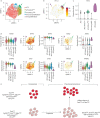Identification of a novel subset of alveolar type 2 cells enriched in PD-L1 and expanded following pneumonectomy
- PMID: 33863742
- PMCID: PMC8859978
- DOI: 10.1183/13993003.04168-2020
Identification of a novel subset of alveolar type 2 cells enriched in PD-L1 and expanded following pneumonectomy
Abstract
Alveolar type 2 (AT2) cells are heterogeneous cells, with specialised AT2 subpopulations within this lineage exhibiting stem cell properties. However, the existence of quiescent, immature cells within the AT2 lineage that are activated during lung regeneration is unknown.SftpcCreERT2/+;tdTomatoflox/flox mice were used for the labelling of AT2 cells and labelled subpopulations were analysed by flow cytometry, quantitative PCR, assay for transposase-accessible chromatin using sequencing (ATAC-seq), gene arrays, pneumonectomy and culture of precision-cut lung slices. Single-cell RNA-sequencing (scRNA-seq) data from human lungs were analysed.In mice, we detected two distinct AT2 subpopulations, with low tdTomato level (TomLow) and high tdTomato level (TomHigh). TomLow cells express lower levels of the AT2 differentiation markers Fgfr2b and Etv5, while TomHigh, as bona fide mature AT2 cells, show higher levels of Sftpc, Sftpb, Sftpa1, Fgfr2b and Etv5 expression. ATAC-seq analysis indicates that TomLow and TomHigh cells constitute two distinct cell populations, with specific silencing of Sftpc, Rosa26 and cell cycle gene loci in the TomLow population. Upon pneumonectomy, the number of TomLow but not TomHigh cells increases and TomLow cells show upregulated expression of Fgfr2b, Etv5, Sftpc, Ccnd1 and Ccnd2 compared to Sham. TomLow cells overexpress programmed cell death 1 ligand 1 (PD-L1), an immune inhibitory membrane receptor ligand, which is used by flow cytometry to differentially isolate these two subpopulations. In the human lung, data mining of a recent scRNA-seq AT2 data set demonstrates the existence of a PD-L1 Pos population. Therefore, we have identified a novel population of AT2 quiescent, immature progenitor cells in mouse that expand upon pneumonectomy and we have provided evidence for the existence of such cells in human.
Copyright ©The authors 2021.
Conflict of interest statement
Conflict of interest: N. Ahmadvand has nothing to disclose. Conflict of interest: F. Khosravi has nothing to disclose. Conflict of interest: A. Lingampally has nothing to disclose. Conflict of interest: R. Wasnick has nothing to disclose. Conflict of interest: I. Vasquez-Armendariz has nothing to disclose. Conflict of interest: G. Carraro has nothing to disclose. Conflict of interest: M. Heiner has nothing to disclose. Conflict of interest: S. Rivetti has nothing to disclose. Conflict of interest: Y. Lv has nothing to disclose. Conflict of interest: J. Wilhelm has nothing to disclose. Conflict of interest: A. Gunther has nothing to disclose. Conflict of interest: S. Herold has nothing to disclose. Conflict of interest: D. Al Alam has nothing to disclose. Conflict of interest: C. Chen has nothing to disclose. Conflict of interest: P. Minoo has nothing to disclose. Conflict of interest: J-S. Zhang has nothing to disclose. Conflict of interest: S. Bellusci has nothing to disclose.
Figures








Comment in
-
PD-L1high AT2 cells: a new player for alveoli regeneration.Eur Respir J. 2021 Nov 4;58(5):2101417. doi: 10.1183/13993003.01417-2021. Print 2021 Oct. Eur Respir J. 2021. PMID: 34737193 No abstract available.
Similar articles
-
Fgfr2b signaling is essential for the maintenance of the alveolar epithelial type 2 lineage during lung homeostasis in mice.Cell Mol Life Sci. 2022 May 19;79(6):302. doi: 10.1007/s00018-022-04327-w. Cell Mol Life Sci. 2022. PMID: 35587837 Free PMC article.
-
Injury activated alveolar progenitors (IAAPs): the underdog of lung repair.Cell Mol Life Sci. 2023 May 11;80(6):145. doi: 10.1007/s00018-023-04789-6. Cell Mol Life Sci. 2023. PMID: 37166489 Free PMC article. Review.
-
Cell-Surface Programmed Death Ligand-1 Expression Identifies a Sub-Population of Distal Epithelial Cells Enriched in Idiopathic Pulmonary Fibrosis.Cells. 2022 May 10;11(10):1593. doi: 10.3390/cells11101593. Cells. 2022. PMID: 35626630 Free PMC article.
-
FGF10 Therapeutic Administration Promotes Mobilization of Injury-Activated Alveolar Progenitors in a Mouse Fibrosis Model.Cells. 2022 Aug 3;11(15):2396. doi: 10.3390/cells11152396. Cells. 2022. PMID: 35954241 Free PMC article.
-
Heterogeneous groups of alveolar type II cells in lung homeostasis and repair.Am J Physiol Cell Physiol. 2020 Dec 1;319(6):C991-C996. doi: 10.1152/ajpcell.00341.2020. Epub 2020 Sep 9. Am J Physiol Cell Physiol. 2020. PMID: 32903031 Free PMC article. Review.
Cited by
-
Epithelial stem cells and niches in lung alveolar regeneration and diseases.Chin Med J Pulm Crit Care Med. 2024 Mar;2(1):17-26. doi: 10.1016/j.pccm.2023.10.007. Epub 2024 Feb 8. Chin Med J Pulm Crit Care Med. 2024. PMID: 38645714 Free PMC article.
-
PD-L1 as a Novel Mediator of Lung Fibroblast to Myofibroblast Transition.J Cell Immunol. 2022;4(4):141-144. doi: 10.33696/immunology.4.142. J Cell Immunol. 2022. PMID: 36437908 Free PMC article. No abstract available.
-
Stem/Progenitor Cells and Related Therapy in Bronchopulmonary Dysplasia.Int J Mol Sci. 2023 Jul 7;24(13):11229. doi: 10.3390/ijms241311229. Int J Mol Sci. 2023. PMID: 37446407 Free PMC article. Review.
-
MHC class II of different non-professional antigen-presenting cells mediate multiple effects of crosstalk with CD4+T cells in lung diseases.Front Med (Lausanne). 2025 Jan 17;12:1388814. doi: 10.3389/fmed.2025.1388814. eCollection 2025. Front Med (Lausanne). 2025. PMID: 39897591 Free PMC article. Review.
-
Fgfr2b signaling is essential for the maintenance of the alveolar epithelial type 2 lineage during lung homeostasis in mice.Cell Mol Life Sci. 2022 May 19;79(6):302. doi: 10.1007/s00018-022-04327-w. Cell Mol Life Sci. 2022. PMID: 35587837 Free PMC article.
References
Publication types
MeSH terms
Substances
Grants and funding
LinkOut - more resources
Full Text Sources
Other Literature Sources
Molecular Biology Databases
Research Materials
Miscellaneous
